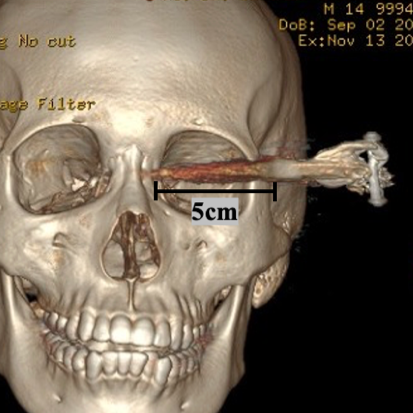UNUSUAL CASE OF A METAL FOREIGN OBJECT IN ORBITOCRANIAL INJURY: UNLOCKING THE MACCARTY KEYHOLE
Abstract
Introduction. Penetrating orbitocranial injuries are quite rare but very fatal if left untreated. Various metal objects have been reported as foreign bodies that have penetrated the orbit. However, unusual objects such as motorcycle locks have never been reported before.
Case Illustration. A 14-year-old boy was brought to the emergency room with a motorcycle lock embedded in his left temporal region. Examination of the left eye showed decreased vision, clear serous ciliary secretions, conjunctival hyperemia, chemosis, and relative afferent pupillary defect. Investigations using a 3D Head MSCT Scan revealed the presence of a metal object that penetrates the left optic nerve, the rectus lateralis muscle, and the frontal process of the left zygoma bone in the left temporal region, which is located around the MacCarty keyhole. The operation in the form of exploration and foreign object removal was then carried out in collaboration with the neurosurgeon. No postoperative complications were reported, but the patient had restricted movement of the left eye.
Discussion. Penetrating orbitocranial injury should be treated as an emergency. Diagnosis should include comprehensive ophthalmological and neurological examinations. CT Scan continues to be the best cranial imaging technique. In this case, the motorcycle lock penetration was around the MacCarty keyhole, a structure that is frequently used to enter both the orbit and the frontal fossa, which located 7 mm superior and 5 mm posterior to the frontozygomatic suture. An appropriate surgical strategy is mandatory for removing the object because it may lead to serious consequences, including cerebral, infectious, vascular complications, and even death.
Conclusion. Metal foreign objects such as motorcycle lock was considered unusual, particulary when it unlock an important landmark such as MacCarty keyhole. This case emphasizes the significance of a surgical strategy based on accurate anatomical tracking.
Full text article
References
1. D’Antone V, Flórez DCP, García CJL, Manrique FDMC, Barbosa NL. Epidemiological findings of childhood ocular trauma in a public hospital in Colombia. BMC Ophthalmol. 2021;21(1):1–7.
2. Yüksel H, Türkcü FM, Çinar Y, Cingü AK, Şahin A, Şahin M, et al. Etiology and prognosis of penetrating eye injuries in geriatric patients in the Southeastern region of Anatolia Turkey. Ulus Travma ve Acil Cerrahi Derg. 2014;20(4):253–7.
3. Dogramaci M, Erdur SK, Senturk F. Standardized classification of mechanical ocular injuries, efficacy, and shortfalls. Beyoglu Eye J. 2021;6(3):236–42.
4. Klančnik M, Ivanišević P, Lupi-Ferandin S, Sučić A, Ledenko V, Lešin M, et al. Penetrating orbitocranial injury. Acta Clin Croat. 2018;57(4):792–6.
5. Agrawal A, Reddy VU, Kumar SS, Hegde K V., Rao GM. Transorbital Orbitocranial Penetrating Injury with an Iron Rod. Craniomaxillofac Trauma Reconstr. 2016;9(2):145–8.
6. Rzaev DA, Danilin VE, Letyagin G V., Istomina TK, Chishchina N V. Penetrating orbitocranial injury: A review of the literature and a case report of injury by a watercolor brush in a 3-year-old child. Zhurnal Vopr Nejrokhirurgii Im NN Burdenko. 2017;81(2):77–87.
7. Ahn SS, Song YJ, Kim KU. Penetrating Orbitocranial Metallic Foreign Body Injury - A Case Report -. J Korean Neurotraumatol Soc. 2009;5(2):103.
8. Amaral MBF, Costa SM, de Araújo VO, Medeiros F, Silveira RL. Penetrating Orbital Trauma by Large Foreign Body: Case Series Study with Treatment Guidelines and Literature Review. J Maxillofac Oral Surg. 2023;22(1):39–45.
9. Sarkar S, Modi S, Seth AK, Panja S. An Unusual Transorbital Penetrating Injury by House-key (lock): A Case Report with a Small Review of Literature. 2Journal Clin Diagnostic Res. 2015;9(9):08–9.
10. Diciano Jr. MD DG, Suzanne Sabundayo-Tiu MD, Elaine Yatco-Omaña MD. A Case of an Orbitocranial Injury with an Unusual Foreign Object. J Ophthalmic Sci. 2021;2(3):45–52.
11. Shimizu S, Tanriover N, Rhoton AL, Yoshioka N, Fujii K. MacCarty keyhole and inferior orbital fissure in orbitozygomatic craniotomy. Neurosurgery. 2005;57(1 SUPPL.):152–9.
12. Tubbs RS, Loukas M, Shoja MM, Cohen-Gadol AA. Refined and simplified surgical landmarks for the MacCarty keyhole and orbitozygomatic craniotomy. Neurosurgery. 2010;66(6 Suppl Operative):230–3.
13. Tabibkhooei A, Aslaninia A, Anousha K. Childhood Transorbital Skull Base Penetrating Injury: Report of 2 Cases and Review of Literature. World Neurosurg [Internet]. 2019;131:213–6. Available from: https://doi.org/10.1016/j.wneu.2019.06.234
14. Bhattacharyya M, Soren AJ, Anuradha A, Prakash O. An Unusual Foreign Body from Domestic Ocular Injury. Indian J Ophtalmol [Internet]. 2022;2(3):786–8. Available from: http://www.ncbi.nlm.nih.gov/pubmed/28331284%0Ahttp://www.pubmedcentral.nih.gov/articlerender.fcgi?artid=PMC5354527%5Cnhttp://bmcpsychiatry.biomedcentral.com/articles/10.1186/1471-244X-11-49%5Cnhttp://bmcophthalmol.biomedcentral.com/articles/10.1186/s12886
15. Barouj MD, Tabrizi R, Behnia P, Tabrizi MAA, Kheirkhahi M. Penetrating Orbital Injury; a Case Report and Treatment Algorithm. Arch Acad Emerg Med. 2020;8(1):e33.
16. Yin HY, Dhanireddy S, Braley AE. Management of an Unusual Orbitocranial Penetrating Injury. Case Rep Ophthalmol Med. 2020;2020:1–5.
17. Wu Y, He W, Yang Y, Chen J. A Rare Case of Orbitocranial Penetrating Injury with Intracranial Wooden Foreign Body Residue. Med. 2022;58(12).
18. Wu Y, Chen T, Yuan M, Mzimbiri JM, Liu Z, Chen Y, et al. Orbitocranial Penetrating Injury With Multiple Vessel Invasion in an Infant: A Case Report and Literature Review. Front Neurol. 2020;11(November):1–6.
19. Hansen MLU, Thorsberger M, Jørgensen JS, Von Buchwald C. Penetrating Orbital Sphenoid Sinus Trauma with a Wooden Stick: A Challenging Case Report. Case Rep Ophthalmol. 2020;11(3):540–5.
20. Jumah F, Adeeb N, Dossani RH. Collin S. MacCarty (1915–2003): Inventor of the “MacCarty Keyhole” as the Starting Burr Hole for Orbitozygomatic Craniotomy. World Neurosurg [Internet]. 2018;111:269–74. Available from: https://doi.org/10.1016/j.wneu.2017.12.121
21. Palejwala SK, Skoch J, Lemole GM. Removal of symptomatic craniofacial titanium hardware following craniotomy: Case series and review. Interdiscip Neurosurg Adv Tech Case Manag [Internet]. 2015;2(2):115–9. Available from: http://dx.doi.org/10.1016/j.inat.2015.04.002
22. Luzzi S, Lucifero AG, Spina A, Baldoncini M, Campero A, Elbabaa SK, et al. Cranio-Orbito-Zygomatic Approach: Core Techniques for Tailoring Target Exposure and Surgical Freedom. Brain Sci. 2022;12(3):1–17.
Authors
Copyright (c) 2025 Fadiah Gazzani Rahman, Andi Pratiwi, Halimah Pagarra, Suliati P. Amir

This work is licensed under a Creative Commons Attribution-NonCommercial-ShareAlike 4.0 International License.

